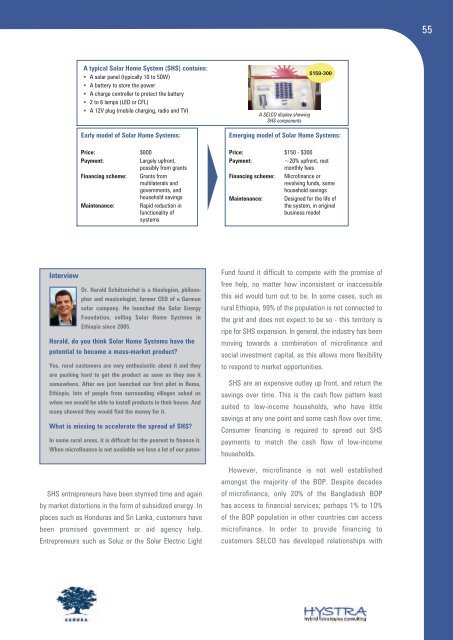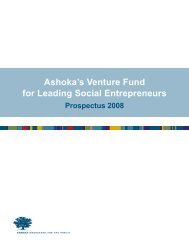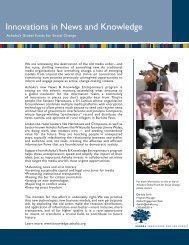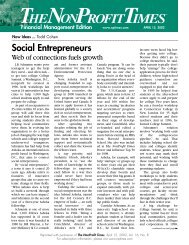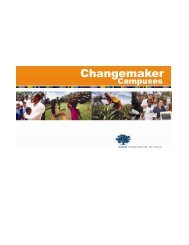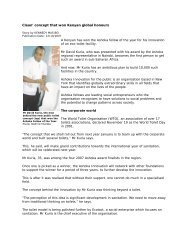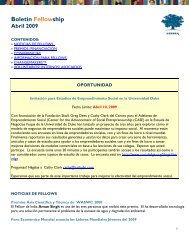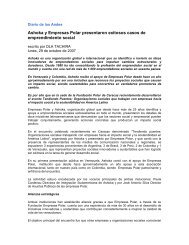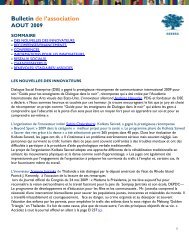Access to Energy for the Base of the - Ashoka
Access to Energy for the Base of the - Ashoka
Access to Energy for the Base of the - Ashoka
Create successful ePaper yourself
Turn your PDF publications into a flip-book with our unique Google optimized e-Paper software.
Interview<br />
Solar Home Systems basic description<br />
A typical Solar Home System (SHS) contains:<br />
A solar panel (typically 10 <strong>to</strong> 50W)<br />
A battery <strong>to</strong> s<strong>to</strong>re <strong>the</strong> power<br />
A charge controller <strong>to</strong> protect <strong>the</strong> battery<br />
2 <strong>to</strong> 6 lamps (LED or CFL)<br />
A 12V plug (mobile charging, radio and TV)<br />
Early model <strong>of</strong> Solar Home Systems:<br />
Price: $800<br />
Payment: Largely upfront,<br />
possibly from grants<br />
Financing scheme: Grants from<br />
multilaterals and<br />
governments, and<br />
household savings<br />
Maintenance: Rapid reduction in<br />
functionality <strong>of</strong><br />
systems<br />
Source: Hystra analysis<br />
Dr. Harald Schützeichel is a <strong>the</strong>ologian, philosopher<br />
and musicologist, <strong>for</strong>mer CEO <strong>of</strong> a German<br />
solar company. He launched <strong>the</strong> Solar <strong>Energy</strong><br />
Foundation, selling Solar Home Systems in<br />
Ethiopia since 2005.<br />
Harald, do you think Solar Home Systems have <strong>the</strong><br />
potential <strong>to</strong> become a mass-market product?<br />
Yes, rural cus<strong>to</strong>mers are very enthusiastic about it and <strong>the</strong>y<br />
are pushing hard <strong>to</strong> get <strong>the</strong> product as soon as <strong>the</strong>y see it<br />
somewhere. After we just launched our first pilot in Rema,<br />
Ethiopia, lots <strong>of</strong> people from surrounding villages asked us<br />
when we would be able <strong>to</strong> install products in <strong>the</strong>ir house. And<br />
many showed <strong>the</strong>y would find <strong>the</strong> money <strong>for</strong> it.<br />
What is missing <strong>to</strong> accelerate <strong>the</strong> spread <strong>of</strong> SHS?<br />
In some rural areas, it is difficult <strong>for</strong> <strong>the</strong> poorest <strong>to</strong> finance it.<br />
When micr<strong>of</strong>inance is not available we lose a lot <strong>of</strong> our poten-<br />
SHS entrepreneurs have been stymied time and again<br />
by market dis<strong>to</strong>rtions in <strong>the</strong> <strong>for</strong>m <strong>of</strong> subsidized energy. In<br />
places such as Honduras and Sri Lanka, cus<strong>to</strong>mers have<br />
been promised government or aid agency help.<br />
Entrepreneurs such as Soluz or <strong>the</strong> Solar Electric Light<br />
A SELCO display showing<br />
SHS components<br />
$150-300<br />
Emerging model <strong>of</strong> Solar Home Systems:<br />
Price: $150 - $300<br />
Payment: ~20% upfront, rest<br />
monthly fees<br />
Financing scheme: Micr<strong>of</strong>inance or<br />
revolving funds, some<br />
household savings<br />
Maintenance: Designed <strong>for</strong> <strong>the</strong> life <strong>of</strong><br />
<strong>the</strong> system, in original<br />
business model<br />
Fund found it difficult <strong>to</strong> compete with <strong>the</strong> promise <strong>of</strong><br />
free help, no matter how inconsistent or inaccessible<br />
this aid would turn out <strong>to</strong> be. In some cases, such as<br />
rural Ethiopia, 99% <strong>of</strong> <strong>the</strong> population is not connected <strong>to</strong><br />
<strong>the</strong> grid and does not expect <strong>to</strong> be so - this terri<strong>to</strong>ry is<br />
ripe <strong>for</strong> SHS expansion. In general, <strong>the</strong> industry has been<br />
moving <strong>to</strong>wards a combination <strong>of</strong> micr<strong>of</strong>inance and<br />
social investment capital, as this allows more flexibility<br />
<strong>to</strong> respond <strong>to</strong> market opportunities.<br />
SHS are an expensive outlay up front, and return <strong>the</strong><br />
savings over time. This is <strong>the</strong> cash flow pattern least<br />
suited <strong>to</strong> low-income households, who have little<br />
savings at any one point and some cash flow over time.<br />
Consumer financing is required <strong>to</strong> spread out SHS<br />
payments <strong>to</strong> match <strong>the</strong> cash flow <strong>of</strong> low-income<br />
households.<br />
However, micr<strong>of</strong>inance is not well established<br />
amongst <strong>the</strong> majority <strong>of</strong> <strong>the</strong> BOP. Despite decades<br />
<strong>of</strong> micr<strong>of</strong>inance, only 20% <strong>of</strong> <strong>the</strong> Bangladesh BOP<br />
has access <strong>to</strong> financial services; perhaps 1% <strong>to</strong> 10%<br />
<strong>of</strong> <strong>the</strong> BOP population in o<strong>the</strong>r countries can access<br />
micr<strong>of</strong>inance. In order <strong>to</strong> provide financing <strong>to</strong><br />
cus<strong>to</strong>mers SELCO has developed relationships with<br />
55


